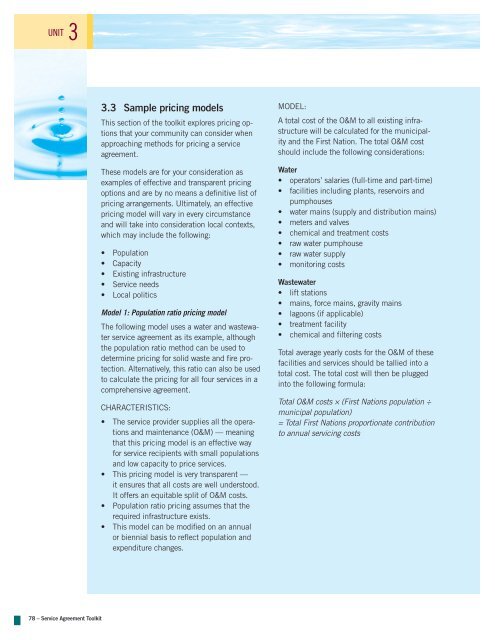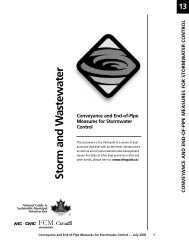Guide to Service Agreements - FCM
Guide to Service Agreements - FCM
Guide to Service Agreements - FCM
Create successful ePaper yourself
Turn your PDF publications into a flip-book with our unique Google optimized e-Paper software.
UNIT 3<br />
78 – <strong>Service</strong> Agreement Toolkit<br />
3.3 Sample pricing models<br />
This section of the <strong>to</strong>olkit explores pricing options<br />
that your community can consider when<br />
approaching methods for pricing a service<br />
agreement.<br />
These models are for your consideration as<br />
examples of effective and transparent pricing<br />
options and are by no means a definitive list of<br />
pricing arrangements. Ultimately, an effective<br />
pricing model will vary in every circumstance<br />
and will take in<strong>to</strong> consideration local contexts,<br />
which may include the following:<br />
• Population<br />
• Capacity<br />
• Existing infrastructure<br />
• <strong>Service</strong> needs<br />
• Local politics<br />
Model 1: Population ratio pricing model<br />
The following model uses a water and wastewater<br />
service agreement as its example, although<br />
the population ratio method can be used <strong>to</strong><br />
determine pricing for solid waste and fire protection.<br />
Alternatively, this ratio can also be used<br />
<strong>to</strong> calculate the pricing for all four services in a<br />
comprehensive agreement.<br />
CHARACTERISTICS:<br />
• The service provider supplies all the operations<br />
and maintenance (O&M) — meaning<br />
that this pricing model is an effective way<br />
for service recipients with small populations<br />
and low capacity <strong>to</strong> price services.<br />
• This pricing model is very transparent —<br />
it ensures that all costs are well unders<strong>to</strong>od.<br />
It offers an equitable split of O&M costs.<br />
• Population ratio pricing assumes that the<br />
required infrastructure exists.<br />
• This model can be modified on an annual<br />
or biennial basis <strong>to</strong> reflect population and<br />
expenditure changes.<br />
MODEL:<br />
A <strong>to</strong>tal cost of the O&M <strong>to</strong> all existing infrastructure<br />
will be calculated for the municipality<br />
and the First Nation. The <strong>to</strong>tal O&M cost<br />
should include the following considerations:<br />
Water<br />
• opera<strong>to</strong>rs’ salaries (full-time and part-time)<br />
• facilities including plants, reservoirs and<br />
pumphouses<br />
• water mains (supply and distribution mains)<br />
• meters and valves<br />
• chemical and treatment costs<br />
• raw water pumphouse<br />
• raw water supply<br />
• moni<strong>to</strong>ring costs<br />
Wastewater<br />
• lift stations<br />
• mains, force mains, gravity mains<br />
• lagoons (if applicable)<br />
• treatment facility<br />
• chemical and filtering costs<br />
Total average yearly costs for the O&M of these<br />
facilities and services should be tallied in<strong>to</strong> a<br />
<strong>to</strong>tal cost. The <strong>to</strong>tal cost will then be plugged<br />
in<strong>to</strong> the following formula:<br />
Total O&M costs × (First Nations population ÷<br />
municipal population)<br />
= Total First Nations proportionate contribution<br />
<strong>to</strong> annual servicing costs
















